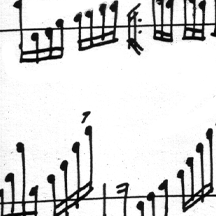|
|
||||||||||||
|
|
|
|
|
|
|
|
|
|
|
|
|
|

=back
Iannis Xenakis, Dmaathen (1976)
Dmaathen was originally scored for oboe and percussion; the oboe part has since been adapted, with the composer’s endorsement, for flute and for soprano saxophone. The piece is in two large sections. In the first, drum outbursts sit atop a soundscape of saxophone multiphonics; the second features declamatory and almost humorous march-like passages from both instruments. These two large parts are framed with a short introduction (with slinky sax lines and tribal drum sounds) and a short coda (with a stately dialogue between the sax and vibraphone). From there, this visceral and bizarre piece quickly dwindles into nothingness.
Iannis Xenakis (1922-2001) was born into a Greek family residing in Braila, Romania. He lost his mother when he was five years old, then was sent off to boarding school on the Greek island of Spetsai at age ten. He studied civil engineering at the Athens Polytechnic, but the German invasion followed by the British occupation drew him into the Resistance, activities from which he would end up near fatally wounded, losing one eye, then later condemned to death. Forced to escape his country, Xenakis ended up in Paris, wanting to study music, but earning a living working as an engineering assistant for Le Corbusier.
His creative and intellectual intensity attracted the attention of both the renowned architect, who delegated architectural projects to him in spite of his lack of professional training, and the composer and pedagogue Olivier Messiaen, who saw in the music he was struggling to produce in isolation an originality deserving of encouragement. Xenakis had his first major succès du scandale with the premiere of Metastasis at the Donaueschingen Festival in 1955, and by 1960, he was able to devote himself entirely to composition.
Critical of other developments in contemporary music at the time, dominated by the serialists (‘Darmstadt school’) such as Pierre Boulez, Luigi Nono, and Karlheinz Stockhausen, Xenakis followed his own path, aided by his background in mathematics, engineering and design, and by his interest in complex sonic phenomena (rainstorms, street demonstrations, etc.). He incorporated probability theory into his compositional approach, as a means of generating and controlling large-scale events composed of massive numbers of individual elements. He also adopted the sonic entity (texture) as the primary material for the construction of musical form (rather than themes, or pitch structures).
Along with his acoustic works, he produced a number of important electroacoustic pieces, and a series of multimedia creations involving sound, light, movement, and architecture (polytopes). In the domain of computer music, Xenakis was a pioneer in the area of algorithmic composition, and also developed an approach to digital synthesis based on random generation and variation of the waveform itself. In addition, he designed a computer system utilizing a graphic interface (the UPIC), which has proven to be a liberating, provocative pedagogical tool as well as a powerful environment for computer composition. - James Harley
=back
| © Yesaroun' Duo |